

Would you walk past? Would you stop the bullies? Would you help a girl? The Modern Bystander Effect and The Death of Kitty Genovese. The brutal murder of Kitty Genovese. Homeless Hero, Hugo Alfredo, died on NYC streets. Apr. 28, 2010— -- Why did more than 20 passersby leave a homeless man to bleed to death on a New York City sidewalk last week?
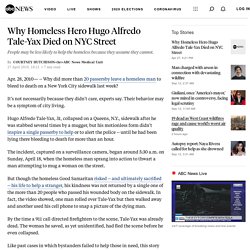
It's not necessarily because they didn't care, experts say. Their behavior may be a symptom of city living. Hugo Alfredo Tale-Yax, 31, collapsed on a Queens, N.Y., sidewalk after he was stabbed several times by a mugger, but his motionless form didn't inspire a single passerby to help or to alert the police -- until he had been lying there bleeding to death for more than an hour. The incident, captured on a surveillance camera, began around 5:30 a.m. on Sunday, April 18, when the homeless man sprang into action to thwart a man attempting to mug a woman on the street. But though the homeless Good Samaritan risked -- and ultimately sacrified -- his life to help a stranger, his kindness was not returned by a single one of the more than 20 people who passed his wounded body on the sidewalk.
How Could People Watch Alleged Gang Rape 'Like An Exhibit'? Oct. 30, 2009 — -- Members of the Richmond, Calif., community were stunned by the alleged rape and assault of a high school student after a school dance last Saturday.
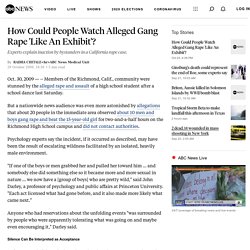
But a nationwide news audience was even more astonished by allegations that about 20 people in the immediate area observed about 10 men and boys gang rape and beat the 15-year-old girl for two-and-a-half hours on the Richmond High School campus and did not contact authorities. Psychology experts say the incident, if it occurred as described, may have been the result of escalating wildness facilitated by an isolated, heavily male environment.
7 teens charged with gang assault in stabbing death of 16-year-old boy broadcast on social media. Seven New York teens caught on video beating Khaseen Morris (pictured), 16, after he already had been fatally stabbed were charged with felonies last week for their roles in the horrific September 16 homicide The seven New York teenagers caught on video beating a defenseless 16-year-old boy who had already been fatally stabbed, are being charged with felonies for their roles in the horrific incident.

Police say Tyler Flach, 18, of Lido Beach, New York is allegedly the man who plunged a knife into 16-year-old Khaseen Morris' heart multiple times outside a Long Island strip mall on September 16. Seven co-conspirators reportedly then pummeled the unarmed and outnumbered teen while an estimated 50 bystanders watched and did nothing except record with their smart phones. At least one person broadcast the deadly encounter on Snapchat. Man dies, but people carry on eating. By BENSON ANG THE man was seated in the coffee shop, and his motionless body was slouched over a table.

For about an hour yesterday, people went about their business - eating, talking and serving food - not realising that Mr Ng Chin Hock was dead. Then the police came, the body was covered up and a few tables cordoned off. And people still went about their business - eating, talking and serving food - while the body lay there for another 31/2 hours or so. More Real life cases (CCTV footages released by NYPD) How the bystander effect can explain inaction towards global warming. Not too long ago, I was preparing a lecture about group dynamics for my students at Delft University of Technology.

One of the dynamics I wanted to introduce was the bystander effect. The bystander effect refers to the phenomenon that an individual’s likelihood of offering help in a critical situation decreases when passive bystanders are present (e.g., Darley & Latané, 1968). The murder case of Kitty Genovese is considered as the iconic real-life example of the bystander effect. Psychology textbooks all over the world describe how in 1964 a young woman was raped and murdered in New York while dozens of neighbours looked on but did not come into action to help her (e.g., Manning, Levine, & Collins, 2007). The New York Times reported on their front-page as follows: Bystanders has also been suggested to reinforce bullying.
Bystander Calculus Model. Bystander Cognitive and Behavioural Processes.
Social Influence. Diffusion of Responsibility. (Article) Factors contribute to the bystander effect. In doing nothing we have still made a decision.
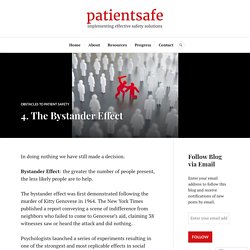
Bystander Effect: the greater the number of people present, the less likely people are to help. The bystander effect was first demonstrated following the murder of Kitty Genovese in 1964. The New York Times published a report conveying a scene of indifference from neighbors who failed to come to Genovese’s aid, claiming 38 witnesses saw or heard the attack and did nothing.
Helping and Prosocial Behavior. People often act to benefit other people, and these acts are examples of prosocial behavior.
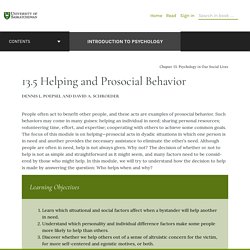
Such behaviors may come in many guises: helping an individual in need; sharing personal resources; volunteering time, effort, and expertise; cooperating with others to achieve some common goals. The focus of this module is on helping—prosocial acts in dyadic situations in which one person is in need and another provides the necessary assistance to eliminate the other’s need. Although people are often in need, help is not always given. Why not? The decision of whether or not to help is not as simple and straightforward as it might seem, and many factors need to be considered by those who might help.
The Effect of Prosocial Priming in the Presence of Bystanders. How to Overcome the Bystander Effect. Psychologists have long been interested in exactly why and when we help other people.
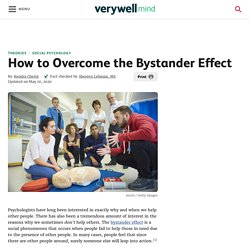
There has also been a tremendous amount of interest in the reasons why we sometimes don't help others. The bystander effect is a social phenomenon that occurs when people fail to help those in need due to the presence of other people. In many cases, people feel that since there are other people around, surely someone else will leap into action.1.